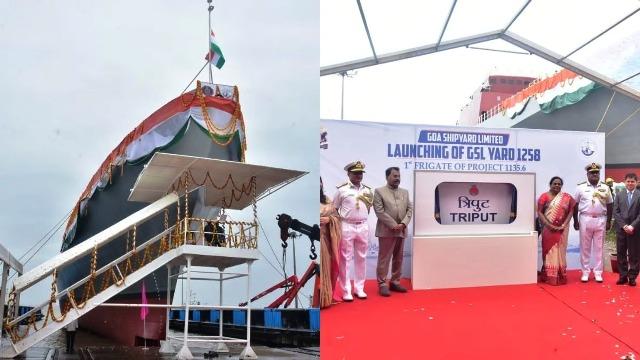SOURCE: IDRW.ORG


Goa Shipyard Limited (GSL), a key player in India’s naval shipbuilding sector, is on track to deliver the first of two Triput-class frigates, named Triput (Mighty Arrow), to the Indian Navy by the end of 2026. The warship, launched last year, is currently undergoing external fitments, marking a significant milestone in India’s push for indigenous defense manufacturing. GSL confirmed this timeline in a statement to idrw.org, underscoring its commitment to bolstering the Indian Navy’s surface fleet with advanced, domestically built vessels.
The Triput-class frigates are part of a broader effort to enhance the Indian Navy’s capabilities, building on the legacy of the six 1135.6 frigates currently in service under the Talwar-class and Teg subclass, ordered in two batches of three each. Additionally, four more 1135.6 frigates are under construction—two at Russia’s Yantar Shipyard and two at GSL—under a $2.5 billion project. However, delays have plagued the Russian-built ships, with the first frigate, Tushil, now expected by September 2024, and the second, Tamal, slated for February 2025. In contrast, GSL’s progress with the Triput-class highlights India’s growing self-reliance in naval shipbuilding.
A standout feature of the Triput-class frigates is their construction using entirely Indian steel for the hull, a departure from the imported materials used in earlier 1135.6 frigates. This shift reflects India’s emphasis on indigenization, a trend further evident in the substitution of multiple major systems with homegrown equivalents. The Triput subclass will incorporate an indigenous Combat Management System, the Surface Search Radar (SSR-4), the Shakti Electronic Countermeasure System, and the Hull Mounted SONAR (HUMSA NG), showcasing the maturity of India’s defense industry.
The armament of the Triput-class frigates also marks a significant upgrade over their predecessors. Unlike the Talwar and Teg classes, which feature the 100mm A-190E naval gun and two twin 533mm torpedo launchers, the Triput subclass will be equipped with the 76mm Super Rapid Gun Mount (SRGM) and two Indigenous Triple Torpedo Launchers (ITTL) designed for 324mm lightweight torpedoes. Additionally, the four frigates of the Triput and Tushil subclasses will feature 24 vertically launched Shtil-1 surface-to-air missiles, replacing the arm launcher Shtil-1 system with a magazine capacity of 24 found in earlier classes. This vertical launch system enhances the ships’ air defense capabilities, offering greater flexibility and response time against aerial threats.
The Triput-class frigates are designed to be stealthier and more capable than their predecessors, aligning with the Indian Navy’s requirements for multi-role warships capable of anti-submarine, anti-surface, and air defense operations. The integration of indigenous systems not only reduces dependency on foreign suppliers but also strengthens India’s defense ecosystem by fostering local innovation and production.
NOTE : Article cannot be reproduced without written permission of idrw.org in any form even for YouTube Videos to avoid Copy right strikes. Websites doing illegal reproductions will get DMCA and Legal Notices.